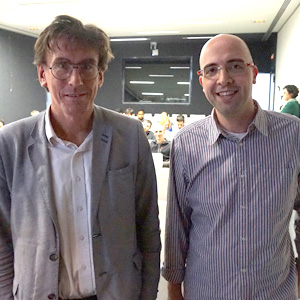Friday, 13 November 2015
Prof. Rafal E. Dunin-Borkowski offers an ICN2 Seminar about recent progress in microscopy of nanomaterials
Prof. Rafal E. Dunin-Borkowski, Research Director of the Institute for Microstructure (Germany), presented a selection of recent results obtained in both high-resolution and Lorentz modes and offered a personal perspective on directions for the future development of transmission electron microscopy. ICREA Prof Jordi Arbiol, Group leader of the ICN2 Advanced Electron Nanoscopy Group, presented this influential speaker.

Prof. Rafal E. Dunin-Borkowskiis the Research Director of the Institute for Microstructure, Ernst Ruska-Centre for Microscopy and Spectroscopy with Electrons Peter Gruenberg Institute Research Centre Juelich (Germany). He leads a series of facilities which have become a reference in Europe for their size and quality. He offered an ICN2 Seminar on November 13, 2015, entitled "Recent progress in chromatic aberration corrected and in situ transmission electron microscopy of nanomaterials". ICREA Prof Jordi Arbiol, Group leader of the ICN2 Advanced Electron NanoscopyGroup, presented this influential speaker.
Transmission electron microscopy has been revolutionised in recent years, both by the introduction of new hardware such as field-emission electron guns, aberration correctors, monochromators, imaging filters and in situ stages and by the development of new techniques, algorithms and software. Chromatic aberration correction, in particular, promises to provide improved spatial resolution and interpretability when compared with the use of spherical aberration correction alone, especially at lower accelerating voltages. It also promises to allow magnetic information about materials to be recorded with a spatial resolution of better than 0.5 nm with the conventional microscope objective lens switched off.
During his talk, Prof. Rafal E. Dunin-Borkowskipresented a selection of recent results obtained in both high-resolution and Lorentz modes from two recently installed field emission gun transmission electron microscopes in Forschungszentrum Jülich in Germany, one of which is equipped with a combined spherical and chromatic aberration corrector on the objective lens. He showed how such studies can be used to obtain unique information about the fundamental physical properties of low-dimensional materials, as well as to measure the local electromagnetic properties of self-assembled materials, including arrays of closely-spaced sub-20-nm ferromagnetic nanoparticles.
The speaker concluded his talk with a personal perspective on directions for the future development of transmission electron microscopy. Such developments may ultimately lead to approaches for characterising the positions, chemical identities and magnetic moments of individual atoms in three dimensions.

